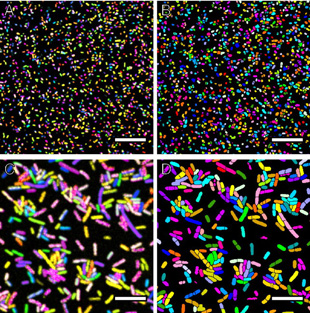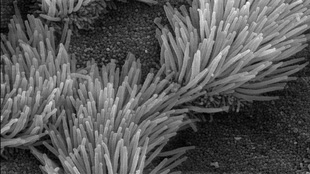From bacterial traps to defective primary cilia to the rapid decline of female fertility, the attendees of the 2011 American Society for Cell Biology (ASCB) meeting , held in Denver, Colorado from December 3 to 7, were buzzing with the cutting-edge research in cell biology. Here are some of the highlights of the meeting.

Illuminating the mouth microbiome
Researchers at the Marine Biological Laboratory in Woods Hole, Massachusetts, unveiled a new fluorescent labeling technology last Tuesday (December 6) for visualizing in full color the microbial communities found in human dental plaque—a biofilm that develops naturally on teeth. The technology, called combinatorial labeling and spectral imaging (CLASI), overcomes the difficulty of simultaneously analyzing...
Bacterial septin trap
When the intracellular bacterium Shigella dysenteriae infect a cell, host proteins called septins aggregate in thin fibers and corral the pathogen, researchers led by Pascale Cossart of the Institut Pasteur reported last Sunday (December 4). By trapping Shigella in septin cages, the cell prevents the bacteria from accessing the structural protein actin, which the bacteria use to form tails that propel them around the cell and into neighboring cells. The immobilized microbes are also eventually targeted for degradation. This is a novel role for septins, which are known to function in cell division and cytoskeletal structure.
Ras’s Achilles’ heel
Despite being the most frequently mutated oncogene in human tumors, the ras protein product, first discovered in the early 1980s, has remained an undruggable target. The main obstacle is ras’s compact structure, which has prevented researchers from finding a functional pocket for a drug to bind to. But after analyzing the interaction of ras with a library of 3,300 small-molecule compounds, scientists at Genentech zeroed in on a binding pocket that, when blocked, interferes with ras’s oncogenic activation. The researchers presented their findings at the ASCB meeting on Sunday, December 4.
When cilia go wrong

Over the past five years, defects in primary cilia—microtubular structures that jut out of nearly every vertebrate cell type—have been linked to an ever growing list of diseases collectively known as ciliopathies. The first of these ciliopathies to be discovered was polycystic kidney disease (PKD), a genetic disorder that results in the formation of fluid-filled kidney cysts. Many of the proteins involved in PKD and other cystic diseases localize to the cilia. Experimenting with a vasodilator hormone called relaxin to treat poor blood flow in a PKD rat model, researchers led by Heather Ward at the University of New Mexico found that the hormone not only improved circulation, but also shrunk kidney cysts. A closer look at the rats’ gene expression revealed that relaxin affects the transcription of genes involved in ciliary trafficking, thus making relaxin a promising candidate for PKD treatment.
Meanwhile, down the hall, scientists led by Nicolas F. Berbari from the University of Alabama presented new data from their lab suggesting that mutations in primary cilia may be an important trigger of obesity. Specifically, they found that in a mouse model of Bardet-Biedl syndrome (BBS)—a rare genetic disease characterized by obesity and malfunctioning cilia—the mutated primary cilia in the hypothalamus are unable to anchor the melanin concentrating hormone (MCH) receptor—an act necessary for the regulation of appetite in normal mice. The results suggest that obesity may be yet another ciliopathy, the researchers said.
Why reproductive cells age faster
In humans, as in biologists’ favorite aging model organism, Caenorhabditis elegans, female fertility declines about halfway through an organism’s lifespan, due to the deterioration of oocyte quality. Signs of general somatic aging, in contrast, seem to kick in much later in life. Working with a C. elegans model of extended lifespan that involves the insulin signaling pathway, Coleen T. Murphy from Princeton University and colleagues found that although both somatic and oocyte aging are intimately tied to insulin regulation, the set of genes involved in the two forms of aging are actually different—suggesting that somatic aging is mechanistically different from reproductive aging. “It seems that maintaining protein and cell quality is the most important component of somatic longevity in worms,” Murphy said in an ASCB press release, “while chromosomal/DNA integrity and cell cycle control are the most critical factors for oocyte health.”
The French-Canadian malady
A team of researchers from Montreal have identified the molecular mechanism behind a rare genetic disorder that commonly affects certain groups of French Canadians. First discovered in the 1970s, autosomal recessive spastic ataxia of Charlevoix-Saguenay (ARSACS) has been linked to mutations in the gene known as sacsin, but the detailed mechanisms of ARSACS have remained a mystery. Presenting last Wednesday (December 7), researchers reported that a group of neurons known as Purkinje cells had abnormally shaped and defective mitochondria in sacsin-knockout mice, which resulted in neuronal death. The results suggest that ARSACS is a neurodegenerative disease driven by mitochondrial dysfunction or misplacement.



